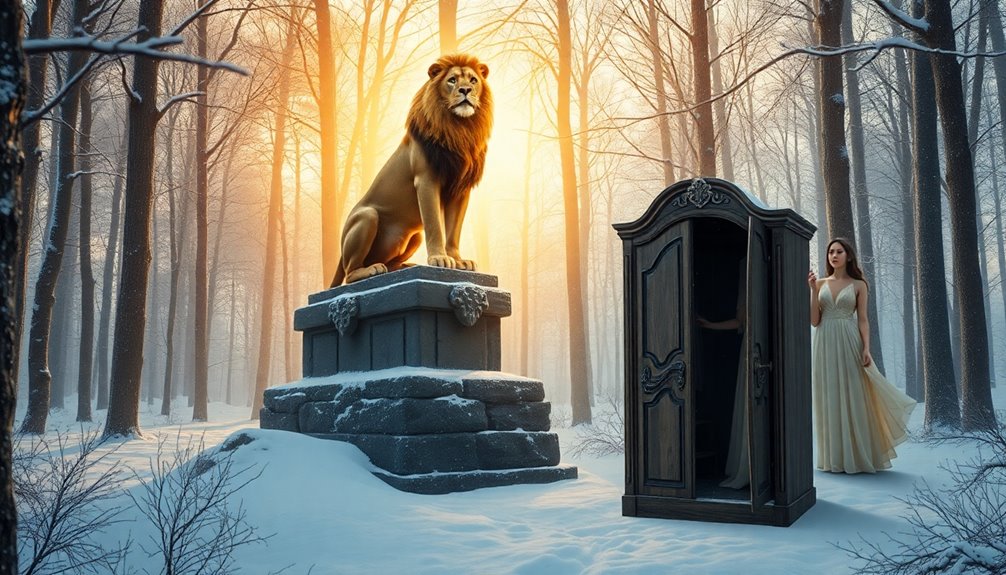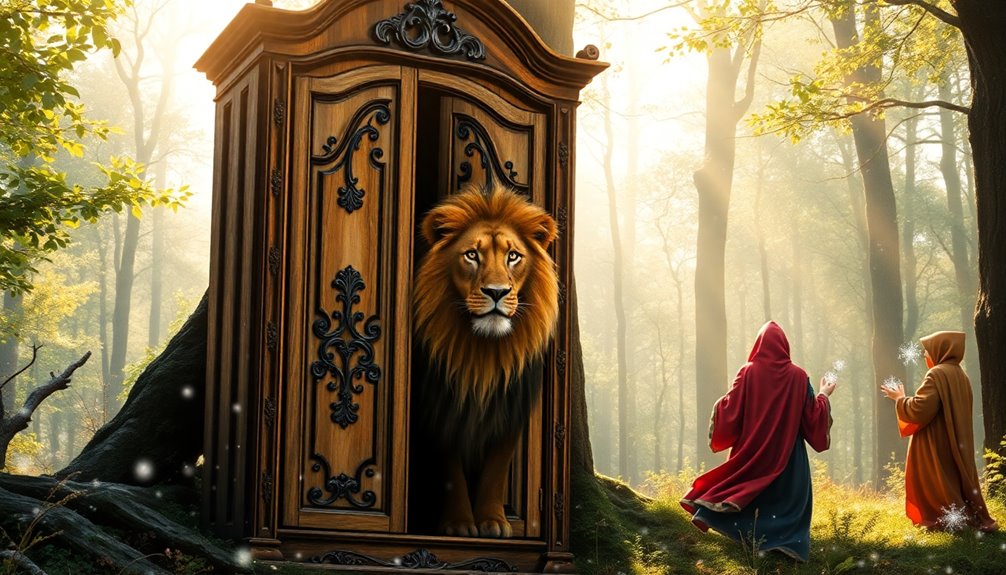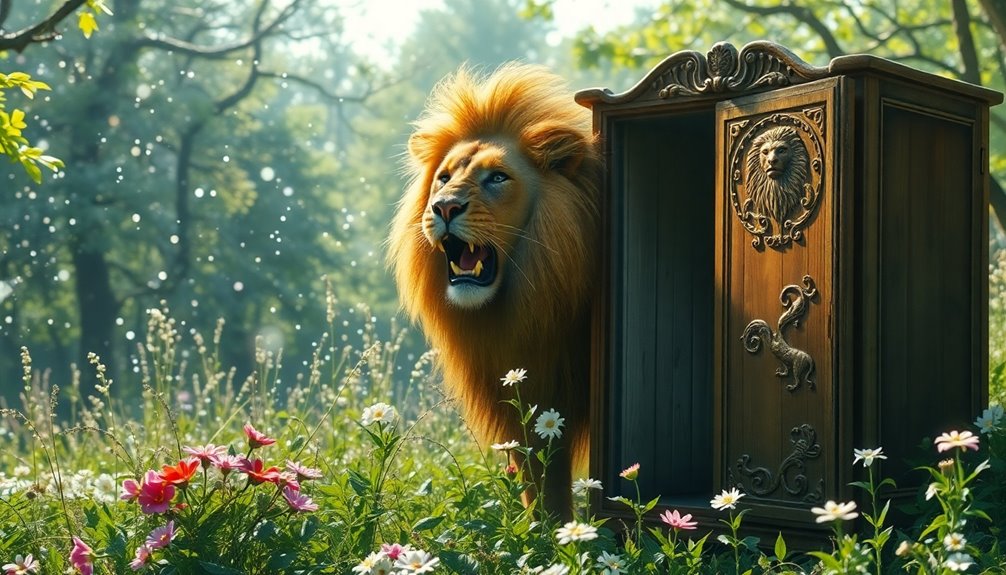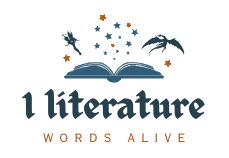The magic in "The Lion, the Witch, and the Wardrobe" draws you into a world rich with moral themes and allegorical depth. Deep Magic, established by the Emperor-beyond-the-Sea, governs Narnia, reflecting justice and sacrifice. Aslan's selfless love and ultimate sacrifice speak to redemption and hope, illustrating transformative power. The contrast between Aslan's healing magic and the White Witch's dark enchantments highlights the struggle between good and evil. This enchanting tale resonates across cultures, inspiring ongoing discussions about its moral implications. Keep exploring, and you'll uncover even more fascinating insights into this beloved classic.
The Concept of Deep Magic

Deep Magic weaves a profound tapestry of laws and principles that govern the world of Narnia. Established by the Emperor-beyond-the-Sea, this deep magic dictates the rights and wrongs in Narnia, including the White Witch's claim to kill traitors.
The Stone Table stands as a powerful symbol of this magic, inscribing its immutable laws while embodying authority. Central to the concept is the deeper magic, which allows for the reversal of death in the case of an innocent, willing sacrifice. This notion of sacrifice echoes the theme of moral growth and transformation found in Dickens' portrayal of characters who grapple with their pasts and seek redemption. In many ways, these themes resonate with the stories of resilience and strength shared by women overcoming adversities in the real world.
Aslan's resurrection exemplifies this profound truth, intertwining themes of redemption and sacrifice. The deep magic reflects Christian allegory, particularly through Aslan, who mirrors Jesus Christ's journey, highlighting the transformative power of sacrifice and hope in Narnia's enchanting domain. This intricate depiction of social injustice draws parallels to the struggles presented in Dickens' works, emphasizing the enduring themes of sacrifice and redemption across literature.
Significant Events of Deep Magic
While exploring the significant events of Deep Magic in *The Lion, the Witch, and the Wardrobe*, you'll find that each moment profoundly impacts Narnia's fate.
The White Witch exploits Deep Magic's decree, claiming Edmund as a traitor, which sets the stage for Aslan's confrontation with her. This confrontation echoes the theme of courage in the face of evil as characters stand against tyranny. The tension between aspirations and harsh realities is palpable as the characters navigate their perilous circumstances.
When Aslan sacrifices himself on the Stone Table, he fulfills Deep Magic, cracking the Table and shifting the power dynamics in Narnia.
However, the deeper magic, which reverses death, comes into play when Aslan rises again, showcasing the power of true sacrifice and redemption.
This resurrection symbolizes the triumph of good over evil, marking a pivotal moment in the narrative where Deep Magic's true essence is revealed, altering the course of Narnia forever. Such themes of collective action resonate with the historical significance of resistance movements that inspire individuals to stand up against tyranny.
Allegorical Meanings Explored

In "The Lion, the Witch, and the Wardrobe," you see how Deep Magic reflects natural law, guiding the characters' actions and moral choices. Aslan's sacrifice reveals profound themes of redemption, while the conflict between good and evil plays out through the struggle between Aslan and the White Witch. These allegorical elements invite you to ponder the deeper meanings behind the story's events and characters. Additionally, the exploration of gender roles in the narrative parallels the complexities of power dynamics found in marriage, enriching the thematic tapestry of the story. Furthermore, the underlying principles of social change echo the actions of unsung trailblazers who fought for justice and equality, emphasizing the importance of moral courage in the face of adversity. This narrative also resonates with the historical impact of women, illustrating how their contributions often shape pivotal moments in society.
Deep Magic's Significance
As you explore the intricacies of Narnia, the concept of Deep Magic reveals itself as a fundamental aspect of the domain's moral framework. Established at Narnia's creation, deep magic governs morality and justice, allowing the White Witch to claim rights over traitors like Edmund Pevensie.
The Stone Table, inscribed with these laws, symbolizes their immutability, which Aslan's sacrificial death ultimately challenges. This act introduces the idea of deeper magic, illustrating how a willing, innocent sacrifice can reverse death.
Scholars view Deep Magic as an allegory for Natural Law, highlighting moral principles and contrasting Aslan's benevolence with the Witch's tyranny. The ambiguity surrounding its nature invites ongoing debate, emphasizing its essential role in understanding the narrative's ethical dimensions within the Narnia series.
Redemption Through Sacrifice
Though the narrative of *The Lion, the Witch, and the Wardrobe* unfolds in a fantastical domain, its exploration of redemption through sacrifice resonates deeply with real-world moral truths.
Aslan's willing sacrifice for Edmund Pevensie serves as a powerful allegory for redemption, mirroring the Christian belief in Jesus Christ's sacrifice. The breaking of the Stone Table at Aslan's resurrection symbolizes hope and renewal, illustrating that deeper magic triumphs over oppressive laws.
- Substitutionary atonement is central to the theme.
- Aslan embodies selfless love and sacrifice.
- His transformation from death to life emphasizes redemption.
- The ultimate victory over the White Witch reinforces the narrative's moral lessons.
- True redemption often involves suffering, echoing profound truths.
Good vs. Evil Themes
The battle between good and evil in *The Lion, the Witch, and the Wardrobe* captures the essence of moral choice and the struggle for righteousness. Aslan stands as a beacon of good, symbolizing Christ, while the White Witch embodies evil and tyranny.
Through Aslan's sacrificial death for Edmund, you witness a powerful theme of redemption, mirroring Christian beliefs. Edmund's journey from betrayal to forgiveness illustrates how the choices you make shape your character.
The Pevensie children evolve from innocent kids to courageous leaders, highlighting the necessity of bravery when confronting evil.
Finally, Aslan's resurrection and the breaking of the Stone Table signify the ultimate triumph of good over evil, revealing that deeper magic and moral law always prevail against darkness.
Scholarly Perspectives on Magic
While exploring "The Lion, the Witch, and the Wardrobe," you'll find that scholarly perspectives on magic reveal rich layers of meaning, particularly surrounding the concept of Deep Magic.
Scholars often interpret Deep Magic as an allegory for Natural Law, emphasizing moral principles that govern Narnia. Its ambiguity leads to various interpretations, especially regarding Aslan's sacrifice and redemption. Additionally, the concept of moral absolutes plays a critical role in the narrative, serving as a guiding principle for characters. The themes of strength and perseverance are also evident as characters navigate their moral dilemmas, showcasing their resilience in the face of evil.
Key insights include:
- Deep Magic represents moral absolutes shaping character choices.
- The relationship between the White Witch and Deep Magic highlights themes of evil.
- Christian allegories deepen the narrative's complexity.
- Scholars debate the implications of Deep Magic on sacrifice.
- It reflects innate laws that resonate with readers' understanding of morality.
- This concept parallels the fragility of individual freedom in dystopian narratives, urging readers to consider the consequences of moral choices.
These perspectives enrich your understanding of the story's moral fabric.
Cultural Significance and Influence

Magic isn't just a narrative device in "The Lion, the Witch, and the Wardrobe"; it also serves as a lens through which we can explore the cultural significance and influence of the story.
Published in 47 foreign languages, it demonstrates a global appeal that speaks to diverse audiences. Ranked ninth in BBC's The Big Read poll in 2003, the book's themes of good versus evil and redemption resonate deeply, shaping interpretations of morality in fantasy literature. The story's emphasis on marginalized individuals' contributions enriches its narrative depth and highlights universal themes of struggle and hope. The characters embody hidden heroes who inspire readers to recognize the power of resilience and courage in the face of adversity.
Its incorporation of Christian allegory has spurred discussions in religious and literary circles, enhancing its cultural legacy. Adaptations into films and theatrical productions continue to inspire new generations, illustrating how the magic of the Chronicles of Narnia endures in popular culture. Additionally, the narrative's exploration of the Civil War parallels themes of personal struggle and resilience found in other literary classics.
Types of Magic in Narnia
In Narnia, magic takes on many forms, from the White Witch's dark enchantments to Aslan's healing powers.
You'll also find the faun's enchanted gifts adding depth to the magical domain.
Each type of magic shapes the story and impacts the characters' journeys in profound ways.
White Witch's Dark Magic
Although the White Witch, known as Jadis, wields formidable dark magic, her powers are rooted in control and manipulation. She creates an eternal winter in Narnia, using her abilities to instill fear and maintain her tyrannical rule. The effects of her dark magic are chilling, as she can turn creatures to stone with just a touch.
- Summoning and commanding wolves and dark beings
- Using spells to enforce her dominance
- Employing magical potions to tempt the unwary
- Manipulating individuals, as seen with Edmund Pevensie
- Creating enchanted objects like Turkish Delight
Yet, the White Witch's dark magic faces a profound challenge from Aslan's deeper magic, which ultimately signifies the victory of good over evil in Narnia.
Aslan's Healing Powers
While the White Witch's dark magic spreads fear and despair across Narnia, Aslan's healing powers offer a profound contrast, bringing hope and restoration.
Aslan's remarkable abilities manifest when he resurrects from death, symbolizing the reversal of the Witch's spell and illustrating the concept of deeper magic. He doesn't just heal the wounded; he restores petrified creatures, showcasing his role as a restorative figure.
His healing powers reflect deep themes of redemption and sacrifice, as his own death and resurrection breathe life back into Narnia. This magic goes beyond physical healing, representing spiritual and emotional restoration, especially for characters like Edmund.
Aslan's healing powers remind you that true magic lies in love, sacrifice, and the triumph of good over evil.
Faun's Enchanted Gifts
Magic in Narnia takes many forms, and the faun Tumnus embodies a unique blend of enchantment that centers on kindness and connection. His gifts create memorable experiences, showcasing how subtle magic can forge bonds.
- Tumnus's enchanting flute music evokes deep emotions.
- His warm hospitality invites Lucy into a world of friendship.
- The faun's initial moral conflict illustrates the complexities of magic.
- Tumnus's protection of Lucy highlights loyalty over betrayal.
- His simple acts of kindness reflect the true spirit of Narnia.
Though not as powerful as the White Witch or Aslan, Tumnus's magic emphasizes the importance of small gestures that foster connection, proving that even the gentlest magic can be profoundly impactful.
Magic Users and Practitioners

In Narnia, you'll encounter a fascinating array of magic users and practitioners, each showcasing unique abilities and purposes.
Among them, the White Witch wields powerful spells and enchantments to manipulate the land and its inhabitants. True magicians like nymphs, fairies, and deities exhibit inherent magical talents, while humans, such as Andrew Ketterley and Queen Lucy, often rely on learning to engage with magic.
Aslan stands as a higher regulatory entity, overseeing the balance of magical laws in this enchanting domain. Additionally, star people possess an innate affinity for magic, allowing them to transform and exist fluidly.
The Hermit of the Southern March exemplifies the diverse applications of magic, using an enchanted pool for observation and insight into Narnia's mysteries.
The Role of the White Witch
The White Witch, or Jadis, stands as a formidable figure in Narnia, claiming the throne and casting a spell of eternal winter over the land. She embodies the forces of evil, manipulating Edmund Pevensie with promises of power and favoritism, leading to his betrayal.
Rooted in the Deep Magic of Narnia, her authority allows her to enforce a harsh moral law, where traitors face dire consequences.
- Represents temptation and deceit
- Serves as an allegory for Satan
- Enforces rigid moral laws in Narnia
- Symbolizes the conflict of good versus evil
- Ultimately defeated by Aslan, restoring balance
Through her character, the struggle between good and evil becomes starkly clear, making her role integral to Narnia's narrative.
The Impact of Narnian Magic

While exploring Narnia, you'll quickly notice how deeply magic influences every aspect of life in this enchanting land.
Narnian magic is complex, shaping the political landscape and character dynamics. For instance, Prince Rabadash hesitates to invade due to the overwhelming presence of magic.
At the heart of it all lies the Deep Magic, a fundamental law that governs moral and magical order, allowing for transformative events like Aslan's sacrifice.
You'll encounter magical beings such as Aslan and Jadis, showcasing a range of powers, from elemental control to transformation spells.
Magical objects, like Lucy's healing potion and Susan's horn, enhance the narrative, proving that when you unite Narnia together, magic plays a vital role in every adventure.
Conclusion
As you close the book on Narnia, you can't help but feel a spark of that deep magic lingering in your heart. Isn't it coincidental that, just like the Pevensies, you too can find a doorway to adventure in the most unexpected places? The magic of this story isn't just in the pages; it's alive in your imagination. So, next time you stumble upon an old wardrobe or a forgotten path, remember—Narnia might just be waiting for you.



